Chesapeake Bay
Do you have any thoughts on this post?
Solutions for the biggest conservation challenges plaguing the Chesapeake Bay actually start at the farthest reaches of the watershed—on out-of-state farms and in Capitol Hill offices
The Chesapeake Bay watershed is one of the most impressive in the world. It covers 64,000 square miles across six states and the District of Columbia. It is home to about 18 million people and 2,700 species of plants and animals—more than any other watershed in North America. Prized sportfish like striped bass (locals know them as rockfish) swim and spawn here, and waterfowl hunters from all over visit for the annual Canada goose migration.
It is truly one of a kind, and D.C. residents are lucky to have the Bay right here in our backyard.
But this watershed also faces some serious challenges. By the mid-20th century it was clear that a few hundred years of intensive urban, agricultural, and industrial development had left the waters toxic and hypoxic, or lacking oxygen. Fish, wildlife, and anyone living or recreating in the watershed had been affected by the negative impacts of pollution.
To help track and improve the health of the watershed, the University of Maryland’s Center for Environmental Science releases an annual Chesapeake Bay Report Card which scores the Bay on its water quality, fisheries health, and other vital signs. The first report card in 1998 gave the Bay a failing grade of 27 out of 100, but the results just released in May scored it at 54 out of 100—a strong uptick, but also showing there’s still a long way to go.
With clean-up efforts showing steady progress right where D.C. policy makers can see it, the Chesapeake Bay watershed could become a true conservation success story and model for the country. Over the next three weeks, we’ll be highlighting some of the major conservation issues remaining for Bay fisheries, some possible solutions, and what this means to sportsmen and women across the region.
Let’s start with what Pennsylvania farmers have to do with Chesapeake Bay rockfish.
With a watershed extending across so many state borders, and with so many species, businesses, and American pastimes at stake, in 1983 an impressive coalition came together to take action. The governors of Maryland, Virginia, and Pennsylvania joined the mayor of D.C., the Chair of the Chesapeake Bay Commission, and the Administrator of the Environmental Protection Agency—operating on behalf of all federal agencies—to sign the first Chesapeake Bay Agreement, an unprecedented commitment to watershed-wide cooperative action to restore the health of the Bay.
But even after three decades, there is much left to be done. So in 2014, the six original partners recommitted to a new Chesapeake Watershed Agreement, and brought the remaining Bay states—New York, West Virginia, and Delaware—into the fold. This new agreement will provide a framework for achieving watershed restoration in the next ten years and beyond.
When thinking about how to clean up the Chesapeake Bay, it’s important to note that the Bay’s waters don’t generally empty out into the Atlantic Ocean. More than 180,000 miles of rivers, streams, and creeks starting as far away as Cooperstown, N.Y. ultimately deposit their waters in the nation’s largest estuary, mingling with tidal waters from the Atlantic. Most of what goes in stays in, so thousands of miles of upstream impacts are concentrated in one downstream basin.
This means that the state of the Bay really depends on what happens in and near the tributaries leading to it. For instance, nutrient pollution from urban development and agricultural lands upstream have negative impacts on rockfish in the estuary, which are sensitive to low oxygen conditions created by toxic algal blooms. (You can read more about what nutrient pollution means for sportsmen right here.)
This is why the 2014 Chesapeake Watershed Agreement focuses on reducing the excess amounts of nitrogen, phosphorous, and sediment loads in the Bay, mostly by helping farmers upstream to keep nutrients on their fields and out of our public waterways.
There is no place more important to this effort than Pennsylvania.
For instance, the total goal is to reduce nitrogen pollution in the Bay by 40.7 million pounds per year. According to the Chesapeake Bay Foundation (CBF), stakeholders have so far only been able to achieve 18.7 million pounds of reductions per year, watershed-wide. But if Pennsylvania were to achieve 100 percent of its state goals, most of which could be addressed through better farming practices, the state could knock out another 19 million of the remaining 21.3 million pounds per year, or 86 percent of the overall Bay’s nutrient reduction shortfall.
To dial it in even further, most of that shortfall could be addressed by tackling farm runoff in just five counties in south-central Pennsylvania.
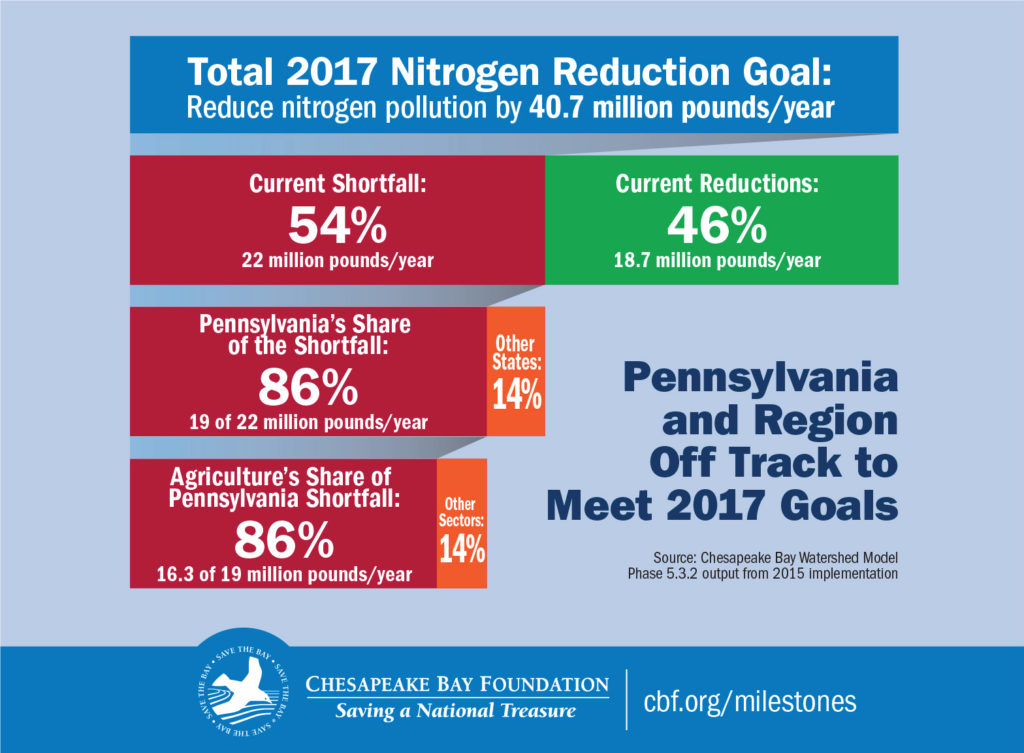
Chesapeake Bay stakeholders have a plan. If Pennsylvania can help its farmers to fully implement a handful of farmland conservation practices, the state could achieve most of the nutrient reduction goals for the entire Bay system. Farmers would get assistance in restoring forested areas alongside streams, strategically converting cropland to grasslands and wetlands, storing manure more safely, and building fencing to keep livestock out of streams.
The problem, as usual, is a lack of local funding to make it happen. Fortunately, the federal Farm Bill is intended to support exactly these types of initiatives.
For instance, the Regional Conservation Partnership Program has a funding stream dedicated to innovative, collaborative, landscape-scale solutions to nutrient reduction challenges in the Chesapeake Bay Watershed. And the Conservation Reserve Program (CRP), which helps farmers, ranchers, and foresters to conserve environmentally sensitive land, is being deployed across the region to help farmers turn unproductive cropland into pollution-reducing stream buffers. CRP’s enhancement program is especially effective at contributing to clean water and better fish habitat in the region.
These critical programs are set to be reauthorized by Congress in 2018. They’re not perfect, and they don’t work everywhere, but we’ll be fighting to renew and improve them for places like the Chesapeake region. Because without $5 billion in annual Farm Bill conservation funding, we have little hope of solving the Pennsylvania problem, and there are similar situations all around the country.
You can help TRCP fight for Bay restoration funding. Tell Congress that you support Farm Bill programs that reduce nutrient pollution, benefit farmers, provide habitat for fish and wildlife, and help to guarantee all Americans quality places to hunt and fish by signing the petition at CRPworks.org.
And of course stay tuned for the rest of our series on efforts to clean up the Chesapeake Bay and rebuild its fisheries, from the bottom of the food chain on up.
Follow our Wyoming field representative as he works within local communities in the Cowboy State
Recently, you heard from my colleague Julia about what it’s like to be a full-time conservation advocate in D.C.—from cab rides to Capitol Hill to reading hundreds of pages of legislation. Well, things look a little different out West.
As a part of our Western Lands team, I’m responsible for advancing the TRCP’s policy priorities for wildlife and public lands conservation here in Wyoming. Like other field reps in Oregon, Nevada, New Mexico, and other states, I’m the main contact between TRCP and hunters, anglers, partners, and decision makers in my state. This makes partnerships with other sportsmen’s groups and volunteers integral to our success. Pulling off this level of collaboration and attending hearings, meetings, and events across the state means I spend my fair share of time on the road too.
Here’s what my typical day looks like:
I start most days studying my calendar, reading emails, and reviewing notes to lay out the priorities for the day. Today I have to hit the road by late afternoon for an evening meeting in our county seat of Lander, about an hour-and-a-half away, and there’s a lot to get done before I go.
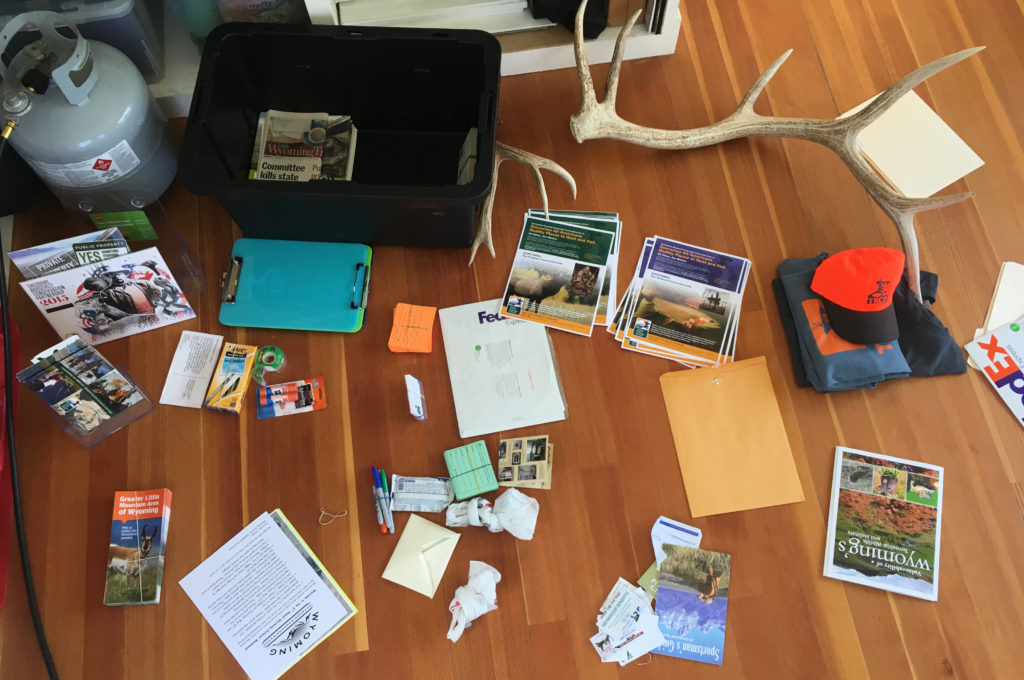
First, I reluctantly visit the mess left over from our table at the Wyoming Outdoor Weekend & Expo. The topic we focused on at the Expo was the Wyoming Public Lands Initiative, a collaborative, county-led process intended to address the status of the Wilderness Study Areas around our state. Representing sportsmen, I sit on the Fremont County committee, and this event was a great opportunity to educate people on the process and how they can engage.
Even though it means I’m on the road on the weekend, I value speaking with local sportsmen and women about our mission and the most pressing conservation concerns where they live—some of which might not be on our radar just yet. I was lucky enough to sign up 65 new TRCP members at the expo, so now I transcribe their names and emails so they can start to hear from us on important issues.
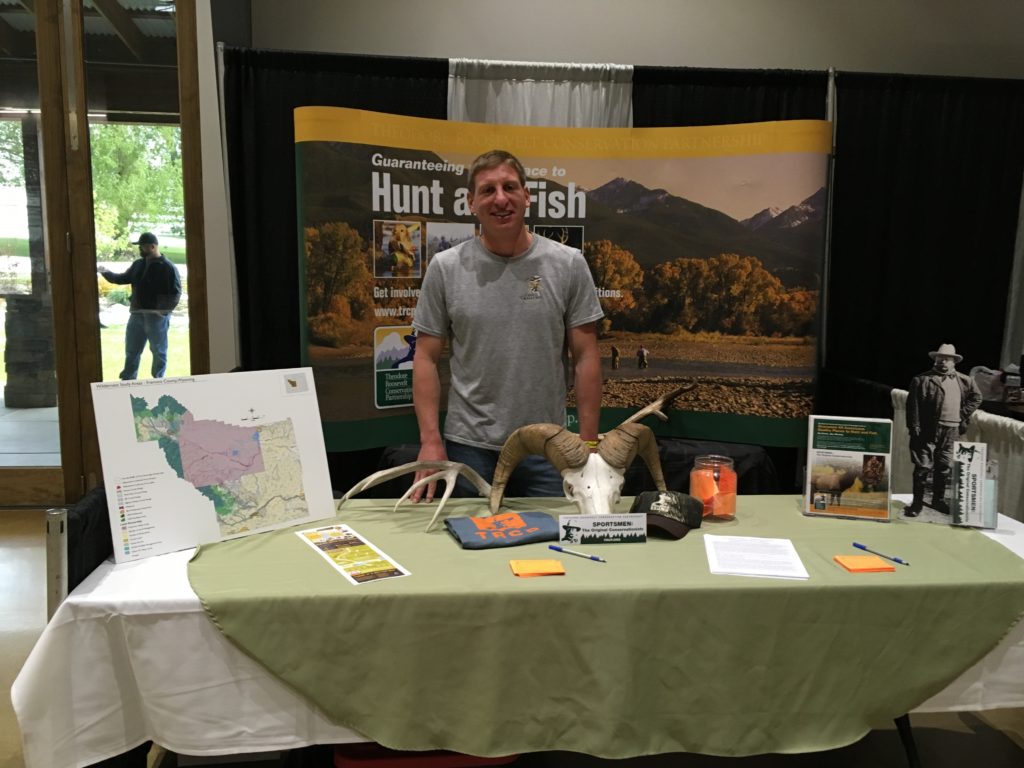
Once I get all my outreach materials organized and put away, I return to my desk to figure out logistics for the next few days. The plan is to stay over in Lander tonight after the meeting and then continue to Rock Springs the next day, where I’ll meet with stakeholders and partners to discuss our work with the Greater Little Mountain Coalition and other issues. Even though I just got home on Saturday night, I pack for a few more days on the road.
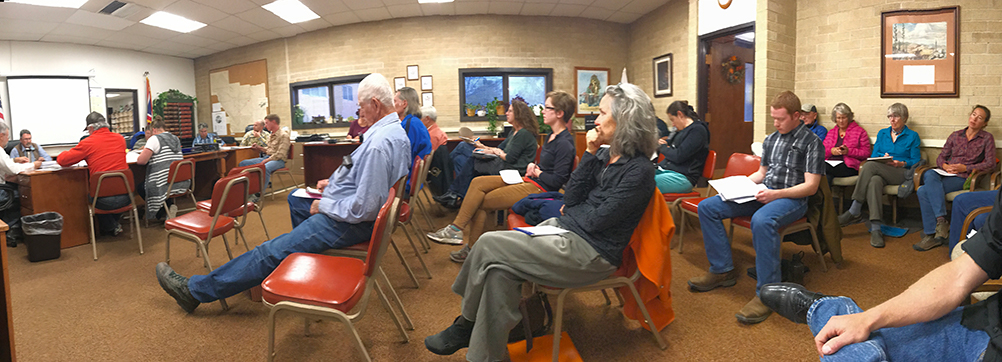
I print tonight’s agenda, review the minutes from the last meeting, and get some emails out the door. I forward an article to Earl DeGroot, TRCP’s Wyoming Ambassador, about Utah’s plans to double the cost the Division of Wildlife pays for the public to access state land. I hear from my New Mexico colleague that their state is dealing with the same issue: costs went from $200,000 to $1 million dollars per year to maintain public access on state-owned lands. This could trickle down to sportsmen through license fees and possibly even jeopardize access in the future—all the more reason to keep our national public lands in public hands.
Earl is dedicated to educating Wyoming sportsmen about the pitfalls of transferring public lands to the states, and he replies that he’s shared the news on a Facebook site he manages. He also sends me a trail-camera photo of a black bear he’s been watching on public land in anticipation of the spring bear hunt. Conversations about hunting and fishing are a regular and welcome part of my work since dedicated conservationists live and breathe this stuff.
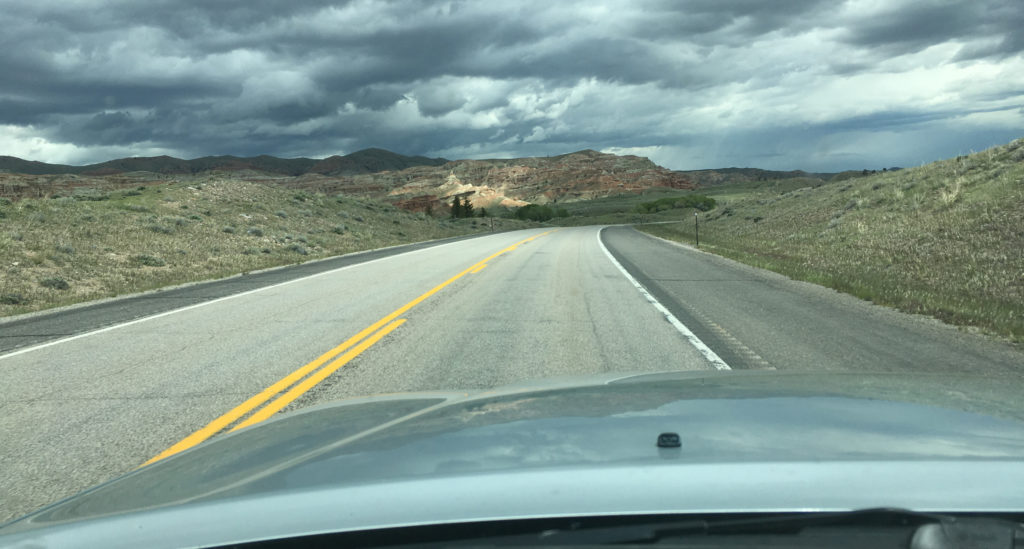
I head out the door and drive south en route to Lander. I won’t hit a single stop sign or stoplight for 75 miles, Welcome to Wyoming! The new episode of my favorite podcast, The MeatEater, keeps me company as I settle in for the beautiful drive.
Windshield time is a big part of the job for the TRCP team out West. When I’m not at home in Dubois, I’m traveling to Lander, Jackson, Rock Springs, our state capital, Cheyenne, and other communities spending between a hour-and-a-half and five hours behind the wheel each way.
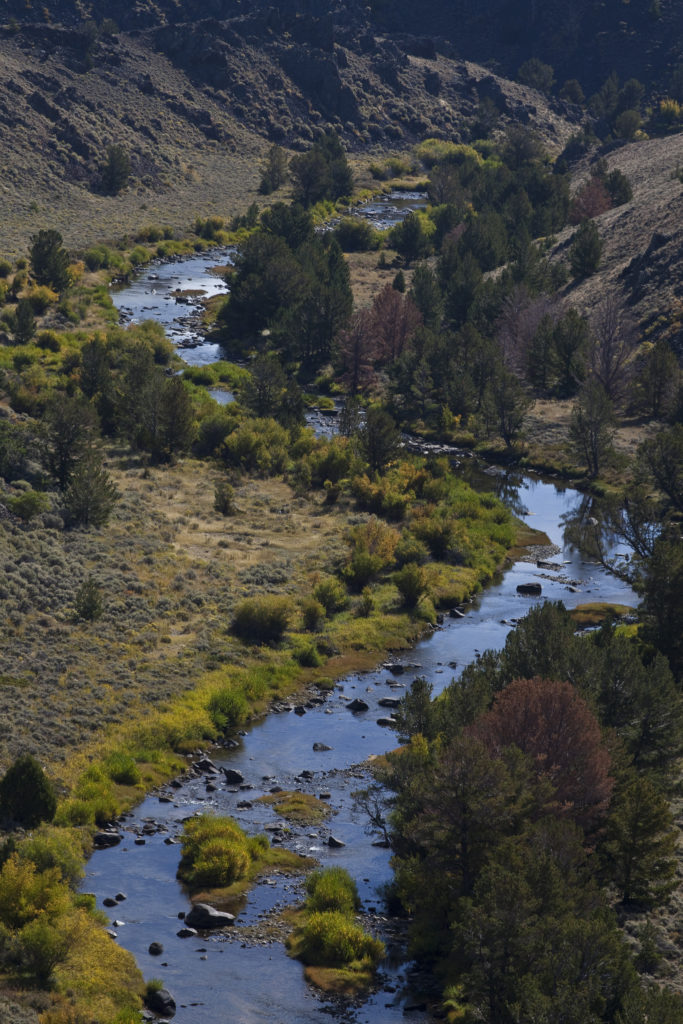
I grab dinner in Lander before heading to the Fremont County Courthouse for our Wyoming Public Lands Initiative meeting. Eight other committee members sit around the large table—only our agriculture representative is missing since, like most ranchers dealing with the extended wet spring season, he’s way behind on work. Behind us in classroom-style rows are staffers from the Bureau of Land Management and Wyoming Office of State Lands and Investments, a commissioner from a neighboring county, a reporter, a rep from Wyoming Wildlife Federation that I work with often, and a few interested community members
The main focus of tonight is filling in our outline for the Sweetwater Canyon Wilderness Study Area. Anglers are deeply invested in the area since the river with the same name holds various trout species, and its remoteness coupled with the lack of development provides a great backcountry fishing experience. We already conducted a field trip to the area last summer and heard from the agencies on current management, as well as the needs of other stakeholders. After hearing public comment, agreeing on some dates for future meetings, and working out logistics for our next field trip, we spend the next two hours working through all the comments that the committee members provided prior. We discuss activities like recreation and grazing in the canyon and adjacent landownership to condense our outline down in order to create a baseline understanding prior to making a recommendation for the Canyon’s future.
Once the meeting wraps up, I’m finally done with a very full workday. I head for my hotel to crash before another day on the road. It’s not always easy to be away from home and my family, but I think back to everyone I talked to at our expo booth over the weekend—the Wyoming sportsmen and women who care deeply enough about our public lands, waters, wildlife, and the future of our hunting and fishing opportunities to stop by and tell me their stories—and I feel lucky to work for something I believe in.
Fly-in season is a busy time on Capitol Hill as folks migrate to D.C. to make a case for policies that strengthen our hunting and fishing heritage
For those who work on Capitol Hill, it’s a familiar sight: Streaming down the steps of a congressional office building, carrying identical totes, a crowd of out-of-towners wait in line to go through security. They’re holding matching folders and chatting excitedly about talking points and appointments. It’s a sure sign that someone in this town has organized a fly-in.
A fly-in is an event where constituents are invited to Washington to lobby lawmakers in a coordinated effort, meeting representatives and staffers face-to-face and sharing their perspectives. Non-profit and advocacy organizations often help participants with scheduling meetings, facilitating training and events, and constructing a unified and effective message for the group.
While advocacy tools like petitions or action alerts can leave some disconnect between a constituent and their representative, fly-ins are about as humanizing as you can get—and sometimes what everyone needs is a face-to-face conversation that leaves both parties more informed.
If you’re an elected official, you’ve got a pretty good incentive to listen to the people who vote in your district. Constituents may not have the same data, nor training, as professional lobbyists, but they have something uniquely impactful: authority gained through on-the-ground life experiences at home.
At the Land Trust Alliance’s recent fly-in, staff briefed participants on key issues and outlined specific asks for lawmakers, like strengthening farm bill conservation programs. Bryan David, LTA’s advocacy & outreach manager, says the voices of their 120 Capitol Hill initiates deliver “a more effective and local message than ‘D.C. insiders’ could provide.”
But that’s not all that makes fly-ins unique or effective. After all, anyone can visit his or her congressional office, even if you’re just in D.C. on vacation.
In 2015, after a spring public lands fly-in hosted by the TRCP and our partners, Dan Harrison made the point that the players working to transfer or sell public lands have an advantage over the sportsmen’s community: They’re laser pointed at the U.S. Capitol while sportsmen and women are spread thin across the nation, keeping an eye on both federal and local issues affecting habitats on public and private land.
By bringing dispersed hunter and angler voices together in D.C., fly-ins facilitate the delivery of a cohesive message, usually including a very specific ask like a particular budget line-item or a policy priority, directly from the mouths of passionate constituents.
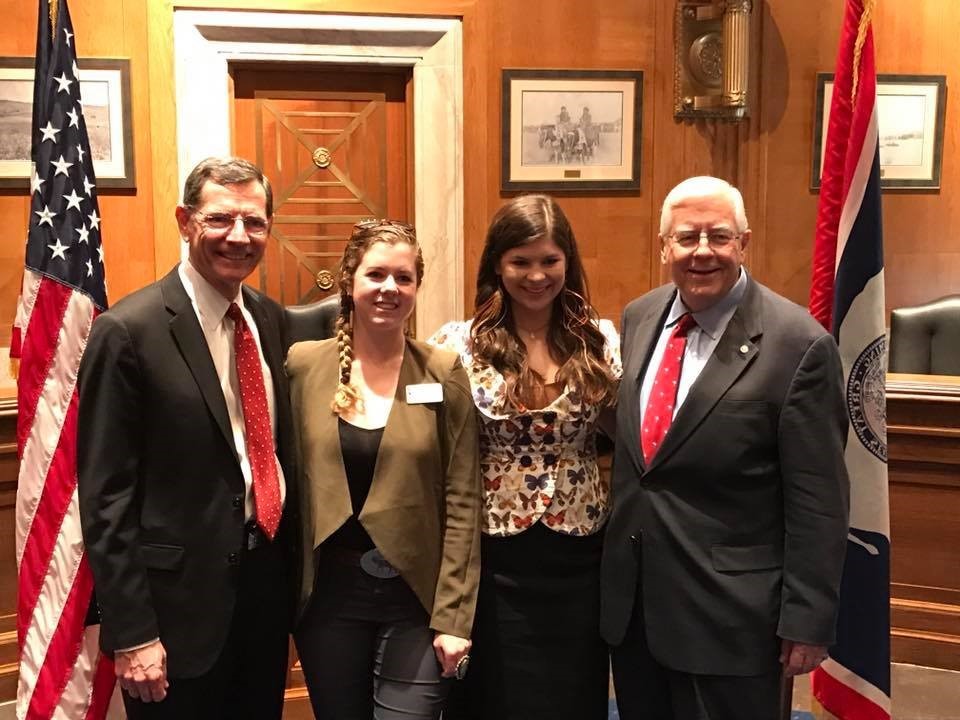
Since work (and life) in D.C. follow the congressional calendar, fly-ins tend to happen in bursts—often referred to as “fly-in season.” A reflection of Congress’ expected appropriations and budget timelines, spring is an especially strategic time to gather the troops and demand stronger programs that benefit access and fish and wildlife habitat.
Right now, lawmakers are crafting bills that allocate money to programs and departments within the federal government. It’s a good time to get in on the ground floor and ensure that our priorities are being considered at the right time.
Last month, National Wildlife Federation gathered representatives from 13 affiliates and outside groups to urge lawmakers to keep public lands public and improve funding for public-land management. They sat down with the people who are at the spearhead of shaping federal policy and discussed their on-the-ground concerns relating to sage-grouse management, wildfire funding, and more.
Just after that, the Outdoor Industry Association hosted 130 executives from their member companies to advocate for public lands and their role in the $887-billion outdoor recreation economy. They had specific asks for the lawmakers, like joining an outdoor recreation caucus and securing funding for the Land and Water Conservation Fund, and worked in unison to drive the point home.
These weren’t the only spring fly-ins in our community this year. Many of our partners have been busy bringing folks into congressional offices to make the case for habitat and public lands—and if all goes according to plan, fiscal year 2018’s federal appropriations bills coming out of the U.S. House and Senate, as well as other legislation this year, will reflect what sportsmen and women care about most.
Fly-ins are only one component of comprehensive and effective conservation advocacy. It takes countless people and a wide variety of efforts coming together to build a strong case for hunting and fishing. For example, when lobbyists—professional or otherwise—go to the Hill, they might tell lawmakers that more than 53,000 people are proud of their public lands, citing the Sportsmen’s Access petition. It’s a big number to throw out, but it’s important to remember that each of those names is an individual who took the time to learn more and take action. When lawmakers see some of those faces in their offices, it gives life to all 53,000.
Advocacy on Capitol Hill isn’t just about what policy staff and government relations professionals do, although their work is immeasurably valuable (seriously, they’re rock stars.) It’s also about how each person who becomes an advocate, whether they come to the Capitol or sign a petition from home, holds within them a lifetime of meaningful experiences—and their stories make a big difference for the future of habitat and access.
As more detail emerges on cuts to conservation programs and agencies in the president’s FY2018 budget, Congress retains the power of the purse
A detailed budget request released today shows that President Trump will continue to push for steep cuts to conservation programs and agencies among other major changes for fiscal year 2018. Today’s announcement expands upon the “skinny” budget blueprint released back in mid-March, which outlined detrimental budget cuts for public and private land management agencies, the Land and Water Conservation Fund, and restoration programs in the Great Lakes and Chesapeake Bay.
New proposed cuts released today include: $1.4 billion decrease to the Department of Interior, $4.6 billion decrease in funding for the Department of Agriculture, $2.6 billion decrease in the Environmental Protection Agency’s budget, and a $1.5 billion reduction to the Department of Commerce budget.
“Sportsmen shouldn’t be surprised that this request is largely along the same lines as Trump’s skinny budget earlier this spring, but we’re not yet in an unworkable position to continue investing in conservation,” says Whit Fosburgh, president and CEO of the Theodore Roosevelt Conservation Partnership. “Congress retains the power of the purse, and based on their recent fiscal year 2017 spending agreement, lawmakers seem to have an appetite for expanding support for habitat, clean water, and the outdoor recreation economy.”
The congressional spending agreement that became law earlier this month stabilized and even increased conservation funding levels through the end of the current fiscal year, thanks to bipartisan efforts from Senate and House leadership. The TRCP and its partners will encourage leadership and appropriators to continue championing conservation funding in FY2018 by passing a budget deal that strengthens and invests in critical programs for the future of America’s fish and wildlife habitat and hunting and fishing traditions.
“Enjoying the outdoors is an American pastime that’s critical to a healthy future for all Americans—from connecting with family and friends on the water while boating or fishing to camping and exploring our national parks—activities that have proven to drive economic growth and provide millions of jobs in communities where there’s access to the outdoors,” says Thom Dammrich, president at the National Marine Manufacturers Association. “Federal investments in conservation make all of this possible and are not expendable. Congress seems inclined to agree, and sportsmen and women will be counting on lawmaker support for conservation and the industry’s 7.6 million outdoor recreation jobs in the fiscal year 2018 budget process.”
Header image courtesy of Bob Wick/Flickr.
Theodore Roosevelt’s experiences hunting and fishing certainly fueled his passion for conservation, but it seems that a passion for coffee may have powered his mornings. In fact, Roosevelt’s son once said that his father’s coffee cup was “more in the nature of a bathtub.” TRCP has partnered with Afuera Coffee Co. to bring together his two loves: a strong morning brew and a dedication to conservation. With your purchase, you’ll not only enjoy waking up to the rich aroma of this bolder roast—you’ll be supporting the important work of preserving hunting and fishing opportunities for all.
$4 from each bag is donated to the TRCP, to help continue their efforts of safeguarding critical habitats, productive hunting grounds, and favorite fishing holes for future generations.
Learn More
